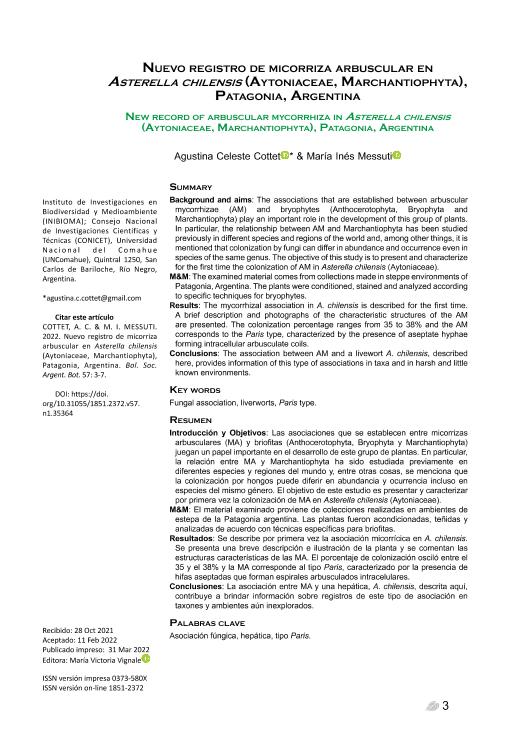Mostrar el registro sencillo del ítem
dc.contributor.author
Cottet, Agustina Celeste

dc.contributor.author
Messuti, Maria Ines

dc.date.available
2023-08-07T12:57:35Z
dc.date.issued
2022-03
dc.identifier.citation
Cottet, Agustina Celeste; Messuti, Maria Ines; Nuevo registro de micorriza arbuscular en Asterella chilensis (Aytoniaceae, Marchantiophyta), Patagonia, Argentina; Sociedad Argentina de Botánica; Boletín de la Sociedad Argentina de Botánica; 57; 1; 3-2022; 3-7
dc.identifier.issn
0373-580X
dc.identifier.uri
http://hdl.handle.net/11336/207119
dc.description.abstract
Introducción y Objetivos: Las asociaciones que se establecen entre micorrizas arbusculares (MA) y briofitas (Anthocerotophyta, Bryophyta y Marchantiophyta) juegan un papel importante en el desarrollo de este grupo de plantas. En particular, la relación entre MA y Marchantiophyta ha sido estudiada previamente en diferentes especies y regiones del mundo y, entre otras cosas, se menciona que la colonización por hongos puede diferir en abundancia y ocurrencia incluso en especies del mismo género. El objetivo de este estudio es presentar y caracterizar por primera vez la colonización de MA en Asterella chilensis (Aytoniaceae). M&M: El material examinado proviene de colecciones realizadas en ambientes de estepa de la Patagonia argentina. Las plantas fueron acondicionadas, teñidas y analizadas de acuerdo con técnicas específicas para briofitas. Resultados: Se describe por primera vez la asociación micorrícica en A. chilensis. Se presenta una breve descripción e ilustración de la planta y se comentan las estructuras características de las MA. El porcentaje de colonización osciló entre el 35 y el 38% y la MA corresponde al tipo Paris, caracterizado por la presencia de hifas aseptadas que forman espirales arbusculados intracelulares. Conclusiones: La asociación entre MA y una hepática, A. chilensis, descrita aquí, contribuye a brindar información sobre registros de este tipo de asociación en taxones y ambientes aún inexplorados.
dc.description.abstract
Background and aims: The associations that are established between arbuscularmycorrhizae (AM) and bryophytes (Anthocerotophyta, Bryophyta and Marchantiophyta) play an important role in the development of this group of plants. In particular, the relationship between AM and Marchantiophyta has been studied previously in different species and regions of the world and, among other things, it is mentioned that colonization by fungi can differ in abundance and occurrence even in species of the same genus. The objective of this study is to present and characterize for the first time the colonization of AM in Asterella chilensis (Aytoniaceae).M&M: The examined material comes from collections made in steppe environments ofPatagonia, Argentina. The plants were conditioned, stained and analyzed accordingto specific techniques for bryophytes.Results: The mycorrhizal association in A. chilensis is described for the first time.A brief description and photographs of the characteristic structures of the AMare presented. The colonization percentage ranges from 35 to 38% and the AMcorresponds to the Paris type, characterized by the presence of aseptate hyphaeforming intracellular arbusculate coils.Conclusions: The association between AM and a livewort A. chilensis, describedhere, provides information of this type of associations in taxa and in harsh and littleknown environments.
dc.format
application/pdf
dc.language.iso
spa
dc.publisher
Sociedad Argentina de Botánica

dc.rights
info:eu-repo/semantics/openAccess
dc.rights.uri
https://creativecommons.org/licenses/by-nc-nd/2.5/ar/
dc.subject
FUNGAL ASSOCIATION
dc.subject
LIVERWORTS
dc.subject
PARIS TYPE
dc.subject.classification
Micología

dc.subject.classification
Ciencias Biológicas

dc.subject.classification
CIENCIAS NATURALES Y EXACTAS

dc.title
Nuevo registro de micorriza arbuscular en Asterella chilensis (Aytoniaceae, Marchantiophyta), Patagonia, Argentina
dc.title
New record of arbuscular mycorrhiza in Asterella chilensis (Aytoniaceae, Marchantiophyta), Patagonia, Argentina
dc.type
info:eu-repo/semantics/article
dc.type
info:ar-repo/semantics/artículo
dc.type
info:eu-repo/semantics/publishedVersion
dc.date.updated
2023-06-29T10:34:00Z
dc.identifier.eissn
1851-2372
dc.journal.volume
57
dc.journal.number
1
dc.journal.pagination
3-7
dc.journal.pais
Argentina

dc.journal.ciudad
Córdoba
dc.description.fil
Fil: Cottet, Agustina Celeste. Consejo Nacional de Investigaciones Científicas y Técnicas. Centro Científico Tecnológico Conicet - Patagonia Norte. Instituto de Investigaciones en Biodiversidad y Medioambiente. Universidad Nacional del Comahue. Centro Regional Universidad Bariloche. Instituto de Investigaciones en Biodiversidad y Medioambiente; Argentina
dc.description.fil
Fil: Messuti, Maria Ines. Consejo Nacional de Investigaciones Científicas y Técnicas. Centro Científico Tecnológico Conicet - Patagonia Norte. Instituto de Investigaciones en Biodiversidad y Medioambiente. Universidad Nacional del Comahue. Centro Regional Universidad Bariloche. Instituto de Investigaciones en Biodiversidad y Medioambiente; Argentina
dc.journal.title
Boletín de la Sociedad Argentina de Botánica

dc.relation.alternativeid
info:eu-repo/semantics/altIdentifier/url/https://revistas.unc.edu.ar/index.php/BSAB/article/view/35364
dc.relation.alternativeid
info:eu-repo/semantics/altIdentifier/doi/https://doi.org/10.31055/1851.2372.v57.n1.35364
Archivos asociados
